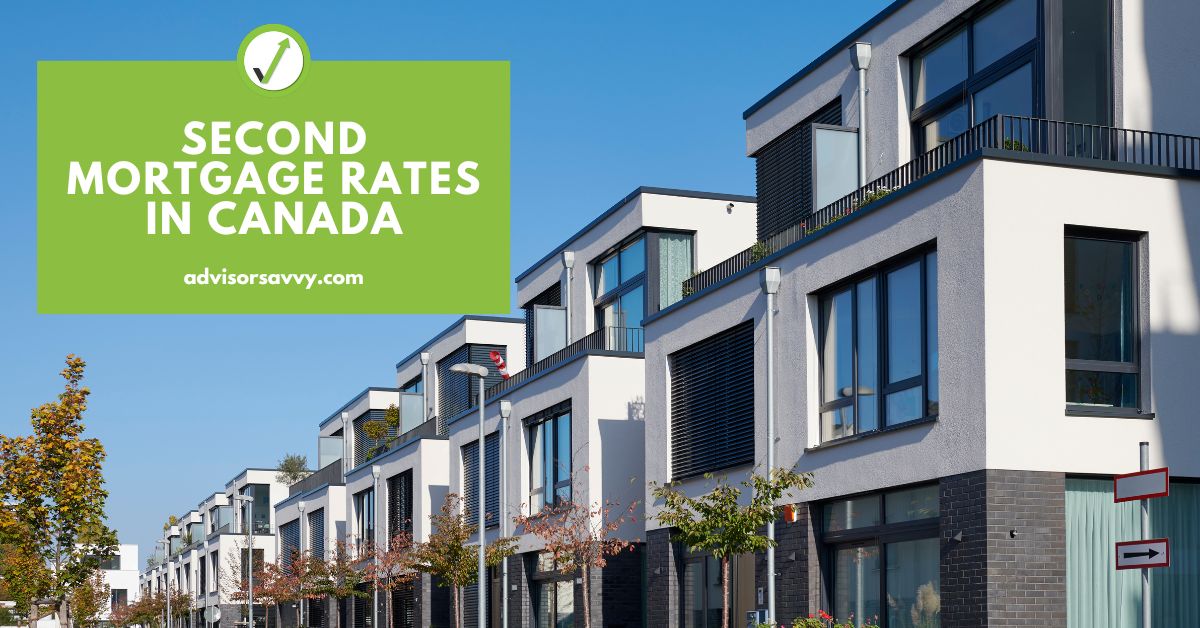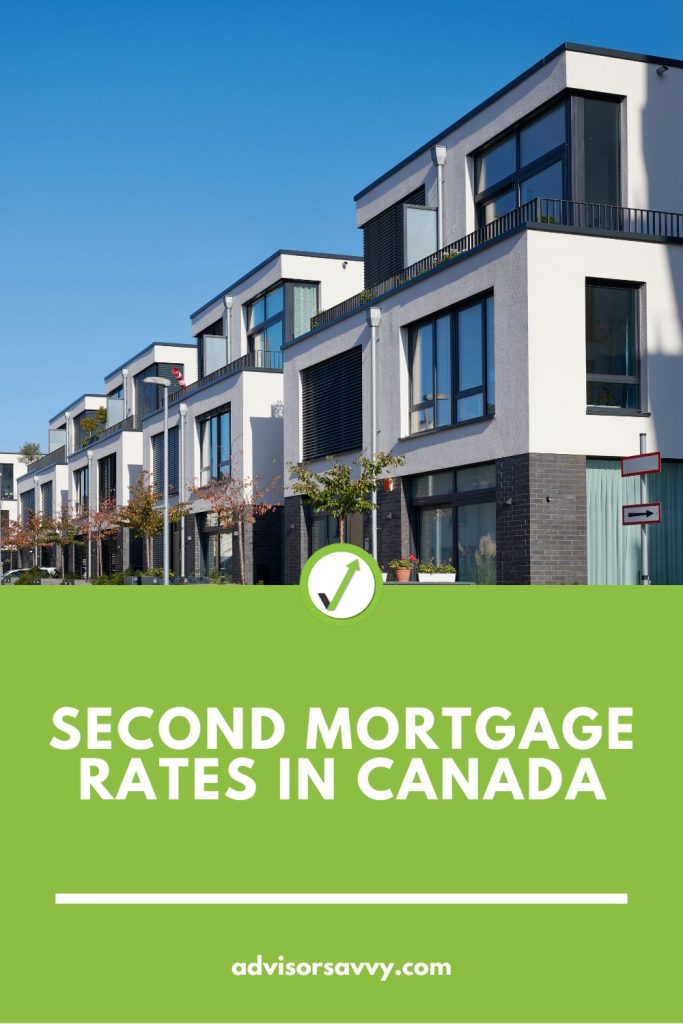
If you are a property owner, you’ve probably found yourself wondering how to tap your property’s equity. Perhaps you need the money for a home renovation or an urgent repair. The answer could be through a second mortgage. These come in multiple forms, with home equity line of credit (HELOC) and home equity loans being the main two. Unfortunately, second mortgage rates are not as good as primary mortgage interest rates. However, they are still very promising and allow you to access equity in your home. Second mortgage rates tend to be better than other lending interest rates. Keep reading to learn more!

Table of contents
Related Reading: Mortgage Refinancing Canada
What is a second mortgage?
A second mortgage is a type of loan taken out against an owned property. It is used to access equity in the property, which is the difference between the market value and the outstanding debt against it. The property would already have an existing first mortgage. In the most basic terms, a second mortgage accesses any value of a property not tied to the first mortgage.
In other words, second mortgages are secondary to the first or primary mortgage. Meaning, that if a mortgage is defaulted, the initial mortgage would be settled from sale first. Then, any remaining funds would go to the second mortgage. For this reason, second mortgages typically have higher interest rates because there’s more risk involved for the lender. Essentially, the borrower is exercising greater financial leverage which is higher risk. However, second mortgage rates remain lower than personal loans, credit cards, or interest rates on other financial products.
Related Reading: Variable vs Fixed Mortgage: What to Know
What are the benefits of a second mortgage?
Second mortgages allow a property owner to access the equity of their property. Equity is the amount that has been paid off, which is calculated as the property’s value less any outstanding debts. It includes any appreciated value of a property since purchase. This results in access to sizeable funds. Accessing this equity can allow you to make other investments which can be profitable down the road. Alternatively, you can access the funds to pay for an urgent home repair at a more reasonable interest rate.
Second mortgages give you access to higher loan amounts, as it is considered a secured loan. Your property is being used as leverage to get the loan. Since it is a secured loan, interest rates also remain competitive. Additionally, interest rates for second mortgages are slightly higher than first mortgages.
What is the downside to a second mortgage?
Second mortgages have downsides. They increase your overall debt load, increase your monthly expenses, come with higher interest rates, and have upfront costs and fees. In addition, leveraging the equity in your home is high risk.
By increasing your debt load and tying another loan to your home, you increase your risk of foreclosure. If you stop paying either of your mortgages, you may lose your home. Either lender can take your home if your default on payments. Second mortgages should never be taken out to cover the basic cost of living expenses. If your cost of living exceeds your current income, it is not worth risking your home. Consider reviewing your budget instead.
Second mortgages come with higher interest rates than primary mortgages. Property owners work very long and hard to pay down mortgages. In the first years of mortgages, most of the payment goes towards interest. After many years, a point is reached where a significant amount of the monthly payment is going towards the principal. Serious thought needs to be placed into if restarting this cycle is worth it.
In addition to increased interest, second mortgages carry closing costs. These are upfront costs needed to close the second mortgage. They include credit checks, appraisals, origination fees, and more. All these things are common in primary mortgages. Second mortgages by extension have similar processes, costs, and fees. These costs can add up to thousands of dollars. However, this will inflate the mortgage and you will be paying extra fees.
How much can I qualify for a second mortgage?
When securing a second mortgage, lenders are restricted to how much they can lend a property owner. In general, lenders are allowed to lend out up to 80% of the total value of a property. This is commonly known as the loan-to-value (LTV) ratio.
For example, a property may be worth $1 million, and the remaining primary mortgage is for $500,000. This means the owner has an additional equity of $500,000, or 50% of the home’s total value. The LTV would be a maximum of 80% of the property value. In this example, the property owner would be eligible for a maximum second mortgage of up to $300,000, or 30% of the property because 50% is already debt. Of course, this is additionally restricted to a lender stress test. Which would take a property owner’s income, credit score, and additional factors into consideration.
The general answer to how much a property owner can qualify for a second mortgage is: up to a maximum of 80% of the untapped equity of the property. This is subject to other qualifying factors and considerations a lender may have.
Related Reading: What Is Debt Consolidation?
Types of Second Mortgages
There are three types of second mortgages. Home equity line of credit (HELOC), home equity loan, and private lender mortgages. Let’s explore all three options below.
Home Equity Line of Credit (HELOC)
A HELOC is a loan that functions like a credit card. In other words, it’s revolving debt. A property owner is approved for a line of credit based on the equity available in their property. The funds can then be used as needed. This can be in small sums or larger lump sums, you can draw down as much or as little of the line of credit as you wish. This is useful for home renovations and repairs occurring over time. It can also be beneficial to secure a HELOC for unexpected emergencies or costs as they come up.
HELOC normally has what is known as a “draw period”, this limits the timeframe you can use or withdraw money. Normally, “draw periods” are for 10 years from when the HELOC began. Any used funds incur interest and only the interest must be paid back during the “draw period”. More money can be contributed to the repayment of HELOC at any time, however, it is not required. Once a draw period ends, additional time is provided to repay the loan and any interest. Each HELOC is different and specific agreements must be understood.
Home Equity Loan
A home equity loan functions more similarly to a primary mortgage or personal loan. A lender provides you with a lump sum of money to be used however you would like. This loan comes with fixed and predictable payments over an agreed period. Home equity loans can be from 5 to 30 years in length. They offer more predictability than HELOC but are significantly less flexible. If a home equity loan is not repaid as agreed, a loan holder risks the possibility of foreclosure.
Private Lender Mortgages
Private lenders can offer home equity loans that are easier to secure. Further, private lenders often do not have strict stress tests for loans like traditional banks. Frequently they also offer higher LTV amounts. These are riskier loans and come with significantly higher interest rates as a result. They function like mainstream home equity loans and have fixed payments over fixed periods. Private lenders should not be a first choice but may be a promising route to consider if needed.
Your credit score & report. Always free, forever
It takes 3 minutes to join 20+ million people who trust ClearScore to help them improve their financial future
Do Canadian banks do second mortgages?
Each of Canada’s Big 6 banks offers options for second mortgages. Although, their specific offerings are all different. All the Big 6 offer HELOCs, while BMO and RBC are the only big banks that offer home equity loans. However, all the big banks offer some kind of secured/collateral loans against properties. HELOCs offer the most flexibility when it comes to a second mortgage. If you can qualify for this product, it may be in your best interest to secure this. Then consider other options if it does not work out.
The Big 6 banks in Canada tend to have the strictest criteria to qualify for their financial products, including second mortgages. This can make it challenging for some Canadians to access equity in their home. However, if you do qualify, the banks tend to have the best rates and terms.
Related Reading: Mistakes to Avoid When Paying Off Your Mortgage Early in Canada
What are second mortgage rates in Canada?
Second mortgage rates vary depending on the type of mortgage and the lender. Major banks and credit unions tend to have lower interest rates. Private lenders tend to have higher interest rates. Below is a chart of the average interest rate as of October 2023.
| Second Mortgage Provider | Type of Second Mortgage | Average Interest Rate | Required Minimum Equity in Property |
| Major Bank & Credit Unions | HELOC | 7.2% to 8.2% | 20% to 35% Equity |
| Private Lender | Home Equity Loan | 8.5% to 15% | 15% to 20% Equity |
What are current interest rates on a second mortgage in Canada?
The current interest rate on a second mortgage in Canada is a minimum of the prime rate plus an additional 2%. This would be a very good rate and hovers around 7.2% + 2% at the time of writing. If you can secure an interest rate of 9.2% for a second mortgage, this is considered average and good. However, second mortgages can range significantly in interest, depending on many factors.
Related Reading: What is a REIT?
Are interest rates on a second mortgage higher?
A primary and conventional mortgage gets you the best possible interest rate available. Any other loan, including second mortgages, will have increased interest amounts. Below is a chart of the average types of loans and interest for ease of comparison.
| Type of Loan | Average Interest Rate |
| Primary Mortgage | 5.64% to 6.85% |
| HELOC | 6.95% to 7.70% |
| Unsecured Line of Credit | 8.20% to 14.20% |
| Personal Loan | 8% to 46.96% |
| Credit Cards | 19.99% |
Your credit score & report. Always free, forever
It takes 3 minutes to join 20+ million people who trust ClearScore to help them improve their financial future
How hard is it to get a second mortgage in Canada?
If you have equity in your property, accessing some of your equity is entirely possible. Second mortgages have stress tests and application processes that consider credit scores, income, and additional factors. If you meet the criteria, you can qualify for a second mortgage. It is important to try and secure the best possible interest rate. First, seek out options from big banks and credit unions. If you really need access to additional cash, you can seek out options from private lenders. Second mortgages are a risk, they can increase your overall monthly costs and the additional leverage can jeopardize your home. It should only be considered if it will help improve your financial situation. Not to cover day to day living expenses or frivolous purchases.
Do you need help navigating the application process for a second mortgage? A financial advisor can help. Complete this quick questionnaire to be matched with an advisor today!
Read More: How to Finance a Home Renovation

